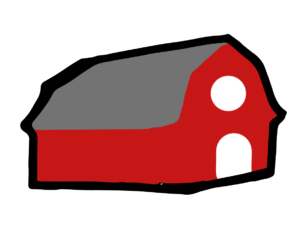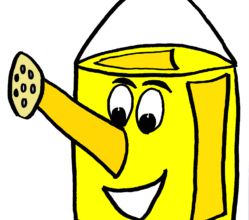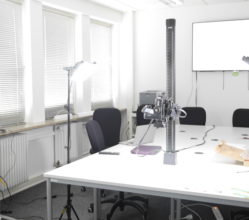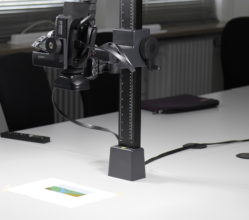This post is also available in: Español (Spanish) Français (French) Deutsch (German) اردو (Urdu)
This article was at first published in German on Insights.
Stop motion is a visual storytelling technique that has been present in film-making for over a century. In fact, it is the first ever animation technique. It creates an illusion of movement by playing a series of individual frames in a fast sequence. In stop motion, ideas are often conveyed by combining art, motion and metaphor.
In RUVIVAL, we use the stop motion technique to explain complex topics in a simple and descriptive visual manner, where language is not in the foreground. The particular style of our videos is called cut-out animation. This technique utilises flat materials, such as paper and fabrics, producing a 2D animation as a result. We focus on using small-scale handmade scenes and we have learned a few things along the way about creating a makeshift stop motion studio. All images used in the RUVIVAL stop motion videos are hand drawn by our collaborators, just as all sound effects are available in the public domain.
Something very important to us is that our videos reach a worldwide audience. Part of our concept is to choose an iconography speaking to an audience of diverse backgrounds by being abstract. Therefore, to use an imagery and symbol language as general as possible. This can be seen especially in the people characters in our videos, which we make in a universal way, without representing and reproducing gender, ethnical or even racial stereotypes making it also easier for the viewer to identity themselves with the situations. An example of our images can be seen below.
Stop Motion Images by RUVIVAL Team are licensed under a Creative Commons Attribution-ShareAlike 4.0 International License.
In these past years, we have also learned that it is not only people characters which make a video universal. For example, in our first videos, houses and farms were drawn resembling a U.S. farm house architecture, a detail we corrected for the newer videos by using more abstract forms as it can be seen in the images below.


Stop Motion Images by RUVIVAL Team are licensed under a Creative Commons Attribution-ShareAlike 4.0 International License.

Stop Motion Images by RUVIVAL Team are licensed under a Creative Commons Attribution-ShareAlike 4.0 International License.
What is the production process like?
We have come a long way since we started making videos in 2016 and since then we have improved our production process. Each production consists of three steps: pre-production, studio production and post-production. Here you can see an overview of the process:
Making of RUVIVAL Stop Motion Videos by RUVIVAL Team is licensed under a Creative Commons Attribution-ShareAlike 4.0 International License.
Part 1. Pre-production
It all starts with a pre-production phase, where all the planning is done and storyboards are reviewed several times before the video is actually filmed. This is done in order to improve the quality of the video and to avoid having to re-shoot scenes as they did not work out like we wanted them to. The first step consists of the student writing a script, which is then reviewed by the supervisors. Afterwards, the script is divided into scenes to create a storyboard. The storyboard is first made in a tabular form, in which it is described what will happen in each scene, what elements will be used and what the narration will be. This is then also reviewed by the supervisors. A template of our tabular storyboard can be downloaded here.
Once the tabular storyboard is approved, an animated storyboard is made on PowerPoint, in which the student uses images taken from our database and/or the Internet and his/her own voice as narration. This animated storyboard is very important for our production process, as it helps us to visualise how the final video will look like and to see if it is made in a way that catches the viewers’ attention. We have learned a few important guidelines that we now follow when creating our videos and these are included in our step-by-step guide below.
2D Stop Motion Step-by-Step Guide by RUVIVAL Team is licensed under a Creative Commons Attribution-ShareAlike 4.0 International License.
The most important points to remember when creating a scene are:
- Follow composition rules used in photography, like the ‘golden ratio’ or the ‘rule of thirds’. The ‘golden ratio’ is based on the ratio of 1 to 1.618, which has been found to create a sense of harmony and balance and can be found everywhere in nature, making it appealing to the human eye. In photography, it can be applied by using the Phi Grid or the Fibonacci Spiral. The Phi Grid is created by dividing the frame into nine sections, resulting in a grid that is 1:0.618:1, and it is applied by placing important elements along these lines and/or intersections; whereas the Fibonacci Spiral is based on the Fibonacci number sequence and it is applied by placing elements with the greatest detail in the smallest quadrangle and the rest of the object along the spiral. The ‘rule of thirds’ is similar to the Phi Grid; however, here the frame is divided into nine equal parts and important elements are placed along the dividing lines and/or their intersections.
- Make the scenes as simple as possible, as having too many elements may confuse the viewers or draw the attention away from important elements.
- Define order of events so there is only one focus point at a time and objects do not have to compete for the viewers’ attention.
- Follow the same style for all drawings used in the video and be consistent, that is, use the same style to depict people, environment, etc.
- Avoid text as much as possible.
After the animated storyboard has been perfected, the images to be used in the video can finally be drawn. We try to use the same style for all the drawings and, as all of the images are hand-drawn by the students, we have developed a style that is simple and easy for everyone. Since the beginning, we have collected all the drawings made for the videos and we now have a database of over 400 images; therefore, the number of new images that need to be drawn for a new video is now very small. When all the images have been drawn, they are printed, cut out and organized into envelopes according to each scene. After this, we are ready to go to the studio.
Part 2. Studio production
The studio production consists of 2 parts: filming the video and recording the audio. Filming is done at a studio at Multimedia Kontor Hamburg (MMKH). This studio has a fixed camera that is set over a table where we arrange each scene and record it. The filming of each stop motion video, with a length of approximately 3 minutes, usually takes 5 to 8 hours. We have seen that by having the images for each scene organised into separate envelopes, we are able to film the video much faster, as each video has dozens of images and sometimes it can take a long time to look for some of the very small images. The audio is also recorded at a studio, but in this case, it is done at a recording studio and by a professional narrator who is a native speaker.
Part 3. Post-production
The last part of the process is the post-production. This is done at the editing room in the Institute of Technical Education and University Didactics (iTBH), where a computer with professional editing software is available. Here, the video images are put together with the audio recorded by a professional narrator. Additionally, sound effects are added to make the video more entertaining. After this, the video is ready to be enjoyed!
As we would like to reach as many people in as many languages as possible, we have made all our videos open to contributions on YouTube, where you can easily add subtitles in any language here. We are very happy to get feedback on our videos, which you can do by sending us a message through our Contact form.
If you would like to see how this production process actually looks like, take a look at the images below.
Video Production Images by RUVIVAL Team are licensed under a Creative Commons Attribution-ShareAlike 4.0 International License.
To watch RUVIVAL stop motion videos, click here. Also, don’t forget to subscribe to our YouTube and Vimeo channels to never miss any RUVIVAL videos!











